|
Holophane

|
Holophane Limited
Elverton Street
Vincent Square
London, SW1
England
|
The two-piece refractor system was designed by Otis Mygatt in 1915. As with many designs produced or acquired by Holophane,
the basic principles of Mygatt's design are still applied today.
The two-piece refractor design was revisited by enginner William Dorey in 1923.
In 1930 Thomas Rolph patented an improvement on Mygatt's design by including sighting marks, or smooth areas
on the refractor with calibrated marks by which the lamp could be accurately adjusted. By making a luminaire body where the
socket could adjust up and down, an electrician could adjust the luminaire so that the lamp was optimally positioned
to give off the most desired illumination pattern with the least glare.
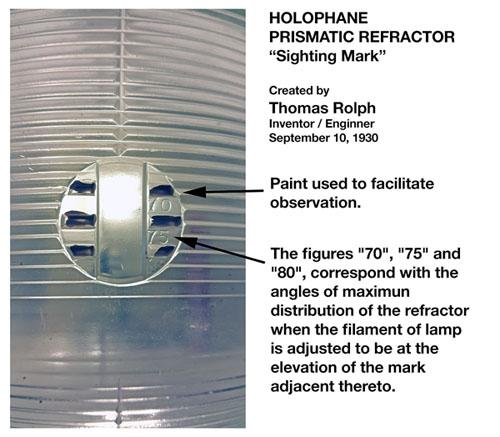
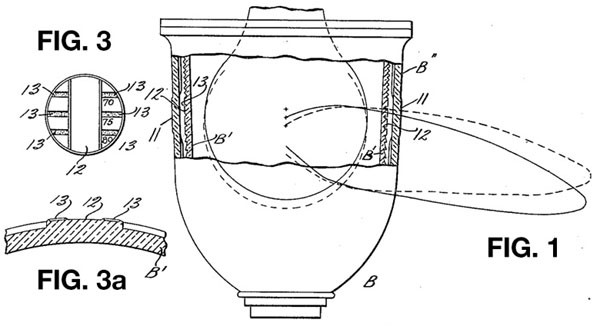
"In the form of sight opening shown in Figures 1, 3 and 3a, the outer envelope B" has a window or spot (ref. Nš11)
of small area, smooth on opposite sides as indicated. opposite this, the inner refractor part B' has a transparent area or
window (ref. Nš12), adjacent to which are marks marks or indicia pressed into the glass, such, for example, as the figures
"70", 75, and 80, which correspond with the angles of maximum distribution of the refractor when the filament (of lamp)
is adjusted to be at the elevation of the mark adjacent thereto. The glass is preferably provided with other marks or
indicia, such as depressions to receive light contrasting material indicated by stippling (ref. Nš13). Paint may be used
or the glass may be etched or otherwise treated to facilitate observation." - Thomas Rolph
Many thanks to Pablo Magne for the info and pictures.
The firm exhibit three types of prismatic refractor at the 1928 APLE Conference in Sheffield. These are:
- Bowl Refractors: Two-way non-axial bowl type for installation at the sides of the roadway;
the two-way axial bowl type for central suspension; the three-way bowl type for "T" intersections; the
four-way bowl type for four-way intersections; and the symmetrical bowl type for covering large areas.
- Band Refractors: Gives a form of light distribution more suitable for spacing on wider thoroughfares.
This form of refractor is generally fitted inside lanterns with clear glass bowls. A new band-type refractor
has recently been designed giving a two-way directional distribution.
- Dome Refractors: These are also for lanterns equipped with outer globes. It is not
made with diffusing prisms, the necessary diffusing of the light rays being effected by the outer globe,
which is made in rippled or frosted glass. Dome-type refractors are also being made with an asymmetric
light distribution, so as to redirect the maximum amount of light away from the house line to the
roadway proper.
- Refractor Plates: A new and particularly interesting Holophane development in directional
street lighting was the square-type gas lantern with four-light burners. These lanterns were fitted with
special prismatic refracting plates of heat-resisting glass for street gas lighting, to control the light rays
from the superheated burner and give a lateral direction to the light distribution. The prismatic plates are
designed for use with square-type lanterns having single or multiple burners. They are easily adapted to
existing lanterns, and when fitted, are readily detached and replaced for maintenance purposes. For ordinary
street-lighting practice two prismatic plates are fitted in a lantern, each axial to the direction of the
street.
In all these Holophane street refractors the prism surfaces are protected from
the collection of dirt and dust. They have smooth surfaces both inside and out, and therefore can
be very readily cleaned.
The Illuminating Engineer, August 1928
The three main groups of prismatic refractor in 1932 are the Bowl, Dome and Band Refractors, and also a large ornamental
type The light control is similar in each case with two members comprising the refractor which encases the prisms between
them - therefore the exterior and interior glass of the refractor is smooth and easily cleaned.
Bowl refractor types:
- Symmetric - Circular distribution for open areas, squares etc.
- Asymmetric - For positions along one side of a road with close spacing or a very wide road.
- 2-Way Non-Axial - Staggered spacing along an average road.
- 3-Way Non-Axial - For "T" junctions.
- 4-Way Non-Axial - For normal crossings.
- 2-way Axial - For central suspension between intersections.
Dome refractor types:
- Symmetric - Circular distribution for open areas, squares etc.
- Asymmetric - For positions along one side of a road with close spacing or a very wide road.
- 2-Way Non-Axial - Staggered spacing along an average road.
Band refractor types:
- Symmetric - Circular distribution for open areas, squares etc.
- 2-Way Non-Axial - Staggered spacing along an average road.
Ornamental refractor types:
- Symmetric - Circular distribution for open areas, squares etc.
- Asymmetric - For positions along one side of a road with close spacing or a very wide road.
The two main types of lantern are the cast iron and spun copper type - APLE Exhibition Catalogue 1932
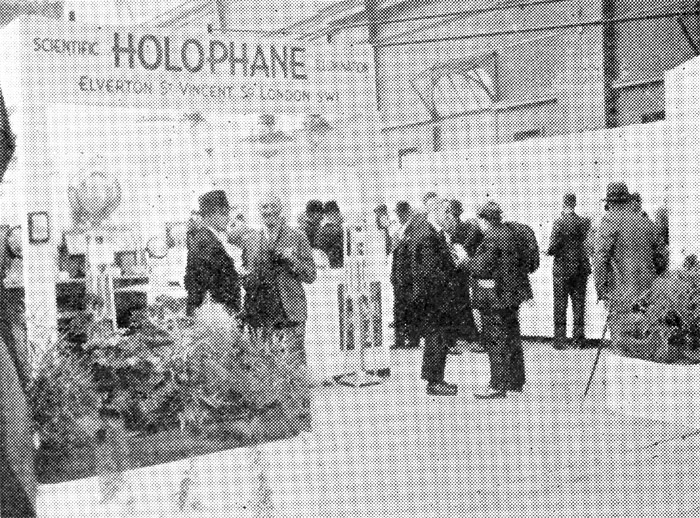
Holophane's stand at the 1936 APLE exhibition in Cheltenham.
At the APLE's 1936 conference in Cheltenham the firm are exhibiting a comprehensive
range of street lighting equipment, the well-known Duo-Dome range
of refractors for gas-filled lamps, the ornamental refractor and the
Lennox Lantern which used a different type of ornamental refractor. - Public Lighting #3, 1936
In 1937, the firm have teamed up with Philips and various manufacturers to
exhibit various lanterns fitted with their 780 Prismatic Panels for 150W SO/H lamps. The
refractor gives very wide lateral light distribution without "glare" and with exceptional visibility.
It is constructed in two pieces with the prisms formed internally so that both exposed surfaces are smooth.
The Bowl Refractor Lantern 564/2/4114 is also being exhibited. - APLE Conference Programme 1937
The firm are exhibiting:
- A new ARP Fitting for industrial yards and open spaces. It has a cut-off reflector with
a special glass filter and an attachable reflector shield to prevent light distribution above the horizontal.
- A new refractor lantern of special shape to be used with horizontal Mercury discharge lamps. (Probably the
Cylinder Lantern of the next year.
- A large ornamental bronze Street Light for 1000-1500W GLS lamps. It has a special three-piece internal refractor
for the illumination of very wide thoroughfares.
- The Bi-Way lanterns with three different types of light distribution.
- The latest types of Holophane Sodium Refractors
- A range of the well-known Duo-Domes.
Interestingly the firm also exhibited lanterns by various gas street lighting manufacturers which used
their gas refractors. - APLE Conference Programme 1938
The new Cylinder Lantern is being exhibited in 1939 along with an improved Lineal
and the Cut-Off, Bi-Way and Duo-Dome lanterns. - APLE Conference Programme 1939
In early 1945, Mr. Ernest Stroud, President of the Illuminating Engineering Society and chief
engineer leaves to become Technical Director
of BLEECO. He was Chief Engineer for Holophane from 1914 until 1940, and General Sales Manager
from 1940 until the present time. He served of a number of Committees of the British Standards Instutution.
He was one of the earliest members of the Illuminating Engineering Society and also the Association Of Public Lighting
Engineers. He has made a special study of modern street lighting technique over the last 20 years. - Public Lighting #37
A brief history of the firm is outlined along with general information
about their street lighting department, formed to give service and information on every
aspect of the subject, and to plan and explain the application of Holophane units. - APLE Conference Programme 1945
At the beginning of the century, when the function of street lighting was mainly the prevention of crime and disorder,
the Holophane organisation foresaw the future lighting problems associated with highway development. A special
department was formed to investigate these problems and to study the application of the scientific principles involved in
controlling and directing the emission of light. Apart from producing efficient lighting units, the Holophane
street lighting department has made an extensive study of the most suitable disposition, spacing and mounting heights
of these units for various classes of roads, including junctions, crossings and conjested areas. For controlling the emission
and re-direction of light, glass was found to be the most satisfactory medium. With Holophane glass, which is
permanently colourless, not only is the minimum of light absorbed, but with the development of prismatic refractors
the light is directed where it is most required. Today Holophane glassware is incorporated by the majority of
the foremost lighting equipment manufacturers throughout the world.
Attention is drawn to the remarkable degree of resistance of Holophane glass refractors to temperature variations, moisture and
atmospheric impurities, and to their robustness and durability, which make them suitable for use in any climate. - APLE Conference Programme 1946
Mr. Justice Vaisey granted an application by Holophane Limited for the extension
of the life of two patents covering dome refractors for street lighting periods for a period of
five years. The two patents (Nos. 337398 and 398419) were taken on in the names of Holophane Limited
and Dr. S. English and referred to Single-piece and Two-piece dome refractors. The original patents
were taken out on 29th July 1940. - Public Lighting #43, 1946
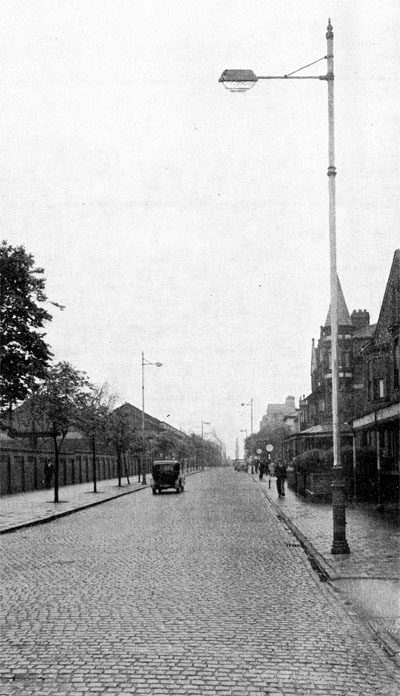
Installation of Dilux lanterns at the 1947 APLE Conference in Southport.
The firm have published a new street lighting catalogue It is more than a well illustrated list
of a wide range of refractors and lanterns; it contains much technical information to interest and
assist the public lighting engineer. The range of refractors covers tungsten-filament and mercury
and sodium discharge lighting. - APLE Conference Programme 1947
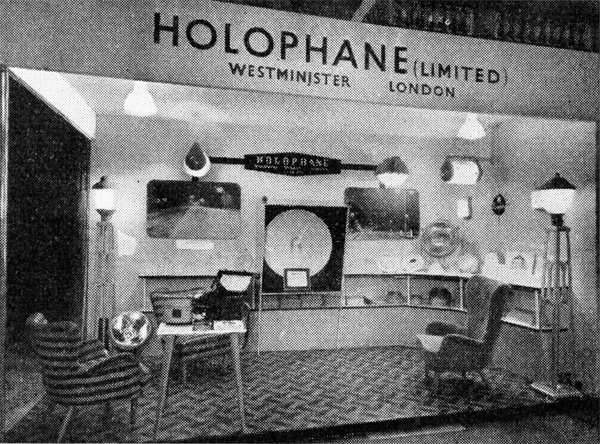
Holophanes' stand at the 1953 APLE exhibition in Liverpool.
References:
The Illuminating Engineer 1928
APLE Exhibition Catalogue Blackpool 1932
APLE Conference Programme Folkestone 1937
APLE Conference Programme Bournemouth 1938
APLE Conference Programme Glasgow 1939
APLE Conference Programme Glasgow 1945
APLE Conference Programme London 1946
APLE Conference Programme Southport 1947
- External Links:
- Grace's Guide
|



